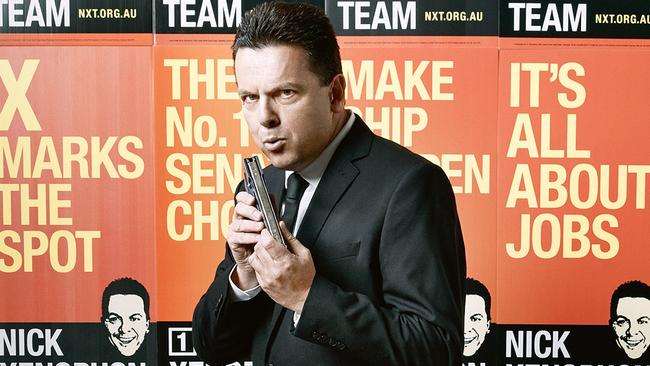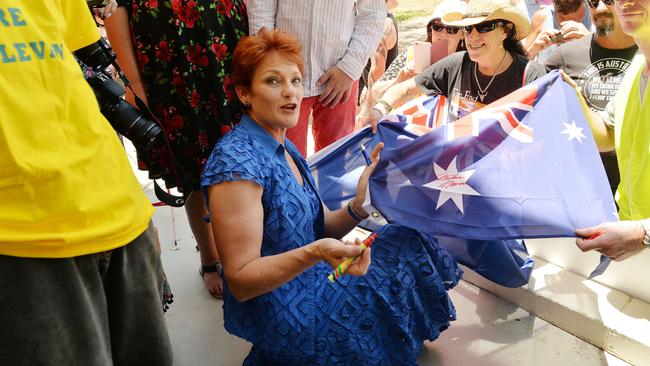Federal election 2016: Gang of eight micro-party senators not going without fight
WHILE new Senate voting rules will make it harder for micro-party senators to get in with small portions of the vote, those who already have a profile could be rewarded.
QLD News
Don't miss out on the headlines from QLD News. Followed categories will be added to My News.
IT has been compared with the bar room scene from Star Wars.
For the eccentric collection of eight micro-party senators, it was party time when they were suddenly thrust into a position of power.
POLL: Record numbers plan to vote for independent
However, for the Coalition Government, which had to win six out of eight of their votes for any legislation that was blocked by Labor and the Greens, it was a nightmare scenario.
By bringing on a double dissolution election this year, Prime Minister Malcolm Turnbull has called last drinks early in that colourful bar.
It’s a move the Government hopes will effectively lock out the problem patrons who only got in with a fraction of the vote. Combined with new voting rules that ban group voting tickets – which saw some crossbenchers win their seats on the back of secretive preference deals – the Government hopes it will be able to permanently lock out some of those they see as troublemakers.

However, pessimists within both major parties think they could soon be dealing with a new set of up to eight minor party candidates.
Just two years into their six-year terms, remaining Palmer United Party senator Dio Wang, Motoring Enthusiast Ricky Muir and former blacksmith John Madigan are almost certain to lose their spots on red leather of the Upper House benches. But it is possible Tasmania’s Jacqui Lambie, NSW’s Liberal Democrat David Leyonhjelm and even South Australia’s Family First MP Bob Day will get back in.
Pauline Hanson is widely expected to return to parliament as a Queensland Senator and Glenn Lazarus is in with a reasonable chance of holding on. In Victoria, “human headline” Derryn Hinch could also win a seat.
And then there’s the Xenophon factor.
Nick Xenophon’s new party is expected to easily win three Senate spots in South Australia with an outside possibility of picking up a fourth in another state.
Instead of a clean sweep of the Senate, this election could result in an ineffective shuffle that leaves things as messy as they were.
While new Senate voting rules will make it harder for micro-party senators to get in with small portions of the vote, those who already have a profile could be rewarded.
This phenomenon will be exacerbated because the quota needed to claim a Senate seat is halved to 7.7 per cent in a double dissolution where all seats are up for grabs.
A further complication is the possibility of votes exhausting if people only preference minor parties, meaning the last spot in each state could be secured with a fraction of the quota.

On the campaign trail, Queensland Labor Senate candidate Murray Watt says there is “both an anti-government sentiment but also a general protest vote that is probably larger than I have seen in other recent elections”.
This analysis has been privately backed by Liberal National Party strategists who fear they can do nothing to stop Hanson’s return.
The unknown factor in Queensland is whether candidates from other right wing parties like Australian Liberty Alliance and Family First will split the conservative vote and nullify each other.
However, Hanson has such name recognition that she is likely to easily eclipse all other fringe candidates.
Her rise could be at the Government’s cost and could see the LNP lose its sixth Senator Joanna Lindgren – an outcome flagged by Deputy Prime Minister Barnaby Joyce who urged potential Hanson supporters to consider their “responsibility to the nation”.
The LNP is only sure of holding five of its six current senate spots in the state, Labor four and the Greens one.
Adding to the Government’s concerns in Queensland is the prospect of Lazarus following his namesake and returning to political life.
The “Brick with Eyes” has won support from militant unions who are staffing his pre-poll booths and is unlikely to be an ally for the Coalition if he succeeds.
The final Senate spot in Queensland is likely to come down to a battle between Lazarus, the LNP, Labor and possibly a second Greens candidate, former Democrat Andrew Bartlett.
Nationally, the look of the Senate could look similar to the current one with the Coalition holding close to 33 seats, Labor 25 and the Greens 10.
All of which means it could be just as difficult for a likely-returned Turnbull Government to get legislation through the Senate.
Bills for the construction industry watchdog and tougher union governance will pass because these double dissolution triggers will be put to a joint sitting of both houses. But for other legislation that Labor and the Greens oppose, the Coalition will need Xenophon on side.
The longstanding SA Independent is a former Liberal who rose to power on a populist anti-pokies campaign and standing up for farmers against Coles and Woolies.
He has since cannily built on anxieties in the state about the decline in manufacturing and steel making in SA.
“Xenophon has been able to take great advantage of the mood in South Australia,” says Flinders University Associate Professor Haydon Manning.
Senior government figures – including Senate Leader, Queensland’s George Brandis – are optimistic about their ability to work with Xenophon compared with the other crossbenchers. If so, they will be able to ignore Hanson, Lazarus and any asserted other oddities who gain a seat.
Negotiating with a block of crossbenchers, especially one controlled by someone who is reasonable, will make for a more stable outcome. But what if the Nick Xenophon Team goes the way of Clive Palmers’ so-called “united” party and splits at some point in the next term?
That’s a horror vision that will haunt the minds of whoever forms government.


